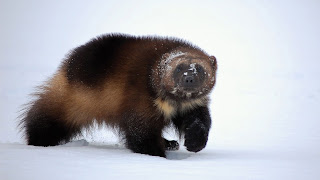The end of winter 2023 was S-L-O-W. We finally put away our snowmachines on April
28. But after that, the transition from ice to water on the lake took a mere two weeks.
When migrating geese and cranes flew overhead in late April/early May, our dog loped toward them, along the hard packed snowmachine tracks that traversed the lake ice, only to be surprised when he sank several inches as he veered off into the soft and rotting snow on either side of the path. We saw the snow change color as both it and the underlying lake ice melted. In some light conditions, the streaks of color looked almost Caribbean: sea green, light blue, and sand colors, until the ice got super thin and looked black.
Within a meager two weeks, KAYAK SEASON arrived. Yea!
Despite plenty of snow on the ground, on May 13, we three kayaked among the ice floes. To my dismay, Buddy jumped off the bow onto
a soft ice floe and sank into frigid water. We
hauled him into the kayak, all 65 pounds of him, and returned home to warm him
up with blankets and food. Two days
later though, the lake was ice free on May 15, as usual. Such a reliably punctual date over many decades. We kayaked along the periphery of the lake while Buddy ran along shore through snowmelt and soggy bogs, throwing off sprays of water. He sniffed all the various scents on air, water, and soil, and looked absolutely delighted. Until mid-Oct, we kayak every day that
lacks high winds or heavy rain, accompanied by homemade wine (for me) and
homemade beer (for Bryan) and peanuts for all three of us. Each week something else blooms, changes color, and scents the air.
As a Labrador mix, our dog is attuned to birds. Fortunately, all water fowl have skills and abilities that exceed his. Like Wiley Coyote, who never caught Roadrunner, Buddy is eager to chase the ducks but never, ever catches one. When from shore he spies a pair swimming, he wriggles his butt, circles his tail, makes a distinctive whine, and jumps into the cold water, swimming toward them. The ducks take his measure, let him approach to a specific distance, and then fly safely to the far shore. By contrast, loons dive with their strong feet and reappear 100 or so feet away. Buddy looks left and right, slows down, and then resignedly paddles to the nearest shore. Foiled again. After a few days of this, the ducks wisely decided to lay nests in the grass and shrubs along the twin lakes behind us, where their progeny can incubate and hatch, unmolested. But adults still visit here, feeding on larvae and perhaps baby pike and pike eggs.
Before 2015, I used to LOVE seeing loons raise and train 8 - 12 soft, fluffy fledglings on our lake. The little ones learned to dive and fly in Keystone Cops commotion. I don’t know why the loons stopped laying eggs here at that time. Since then (7 years before our dog joined us in 2022), we see visiting pairs of loons and many species of migrating fowl but no resident families. It was around that year that spruce beetles devastated the region’s forests, so perhaps other elements of the eco-system attractive to loons changed then, too.
Whatever the reasons may be, each year the changes from winter to spring are fast and dramatic both on the lake and on land. (See blog about land changes in next article).








